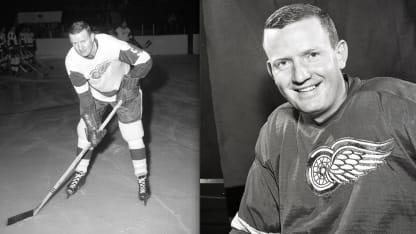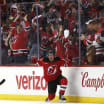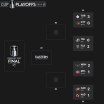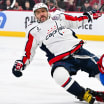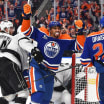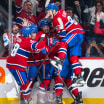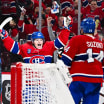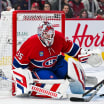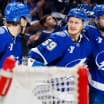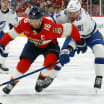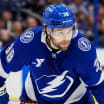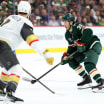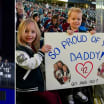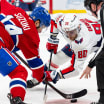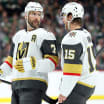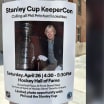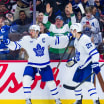Legendary hockey reporter Stan Fischler writes a weekly scrapbook for NHL.com. Fischler, known as "The Hockey Maven," shares his humor and insight with readers each Wednesday.
This week reaches back to the Original Six era when defenseman Doug Barkley surmounted many obstacles to reach stardom with the Detroit Red Wings, only to hit bad luck again. Portions of this interview were gleaned from Shirley and Stan Fischler's book, "Up From The Minor Leagues of Hockey."
Barkley, now 87, played for the Chicago Black Hawks and Red Wings from 1957-66. He coached Detroit from 1970 to '71 and 26 games of the 1975-76 season.
What was Lethbridge, Alberta like for a young hockey player?
"It was strange for us playing outdoors because ice could disappear in a hurry. This was because of a wind called the 'Chinook.' It would blow through the mountain passes from the West and warm everything in sight. The winter temperature could be five below zero in the morning and there'd be ice to play hockey, but within five hours the thermometer would climb 50 degrees and the ice would melt. When the 'Chinook' disappeared, the temperature would dip as low as 40 below zero."
Is it true that you became New York Rangers property at the age of six?
"You could say that. In those days the Rangers sponsored a Junior team in Lethbridge called the Native Sons. Meanwhile, the Sons had their own minor hockey program. The Peewee level team I played for was affiliated with the Sons, so at the age of six -- you could say -- I was already playing in the Rangers minor league chain. Things were different with the way young players were handled by NHL teams in the old days. If I'm not mistaken that's how the Bruins were able to get Bobby Orr."
Which was your favorite position?
"I was so crazy about hockey that I played any position offered to me just as long as I could get ice. Sometimes I'd play up to four outdoor games in a day. There were two teams in the school league that I was on and a Peewee and Bantam team in the regular organized league. When I was 10, I made a deal with the icemaker at the outdoor rink. I cleaned the ice for him and got all the ice I wanted to skate on so I could practice and be able to handle four games in a day."
You also were a young basketball and football star. How come you chose hockey?
"I liked hockey more than anything else. My heart was set on making it eventually to the New York Rangers because I had been connected to the Rangers system for so long. Once I left football and basketball, I tried out for the Medicine Hat junior hockey team but -- believe it or not -- without having a pair of skates or anything, so I borrowed a pair from the team, worked out in three practices and won a contract."
Who were your mentors?
"Two guys. Bob Lindsay, a teacher of mine in Lethbridge, was the one who told me to try out for Medicine Hat and that worked. The second one was my Medicine Hat coach, Alex Kaleta. He was a former NHL player with the Chicago Black Hawks and Rangers. I learned that your first junior coach can have a strong effect on a young player and Kaleta had that positive effect on me. He was a good guy and not only taught me hockey but gave me plenty of ice time for practicing. Plus, the bonus was that he boarded me and two other players at his home."
What was good about Medicine Hat?
"I settled on defense as my position, but Kaleta allowed me to rush the puck, and I scored 20 goals in the first year. Also, I was very grateful to previously be able to survive a really bad basketball accident. It was so bad that the doctor told me I'd never play hockey again. But I managed to recover and got back to hockey with Medicine Hat, and it was there that I learned about discipline from Kaleta. If we lost a game on the road, he'd have us out practicing at 10 or 11 at night. Alex was strict, but for young players that discipline was important."
How did you get to the NHL?
"It was a long haul … I wound up with the Western League pro team in Calgary, the Stampeders. It seemed like a good start until my career nearly ended in Saskatoon. We were playing the Quakers when one of their guys crashed into me and badly damaged my knees. The injury was so serious that I needed surgery."
What was your head like in a traumatic situation like that?
"I thought my hockey career was over then and there, and I wasn't even 20 years old. I had operations on both knees and had to wear a brace on each one when I played. Still, I wasn't going to give up on the game, so I took a chance and went to a health studio in Calgary and worked out with weights. I was determined not to have my career end at that point."
What was the outcome?
"The exercises helped enough for me to attend the Black Hawks camp where I thought I could make the team, but that was the year they brought up Pierre Pilote, Elmer Vasko, Al Arbour, Jack Evans and Dollard St. Laurent. My bad luck, they sent me back to the WHL and later I wound up in the AHL, but no matter how well I played, I couldn't get a break. Some NHL people said I didn't have enough stamina to make it, and they felt I'd never last in the fastest league."
When did the break come?
"I almost quit hockey to take a job with a Calgary oil company, but my Calgary coach, Alf Pike, gave me all the confidence I needed. He played me between 50 and 55 minutes a game and just let me go out there and do my thing. I was only 25 at the time. You could say that I had become a minor league star with 74 points in 70 games and MVP in the All-Star Game, but my real break came when Chicago traded me to Detroit for Len Lunde and John McKenzie (on June 5, 1962), and I wound up at the Red Wings' training camp."
What was it like?
"Wonderful. I was with very friendly players like Gordie Howe, Alex Delvecchio and Marcel Pronovost. Right off the bat, they asked me to golf with them, but I didn't have any clubs, shoes or anything. Gordie, who had been hurt, made me feel right at home and gave me all his golf stuff. On top of that Sid Abel was a wonderful coach, easy to talk to and he gave me plenty of ice time. I finally felt I had made the NHL. I played 70 games and scored three goals and 24 assists for 27 points. Despite all the previous hardships, at last I felt I belonged."
How sure were you?
"I missed rookie of the year by a point to Toronto's Kent Douglas. A year later I had 115 penalty minutes and 32 points and became the best scorer of Detroit's defenders. I really was going strong well into the 1965-66 season with 20 points in 43 games and a ton of ice time. There were moments when I'd be dead-tired, but Sid would say, OK, Alex, Gordie, (Bill) Gadsby and Doug get on the ice.' I'd go out there -- and I pushed myself -- mostly because I figured if Gordie could make it, I could do it."
And then tragedy struck -- again!
"Yeah, it was past the middle of the season when I got hit in the eye by Doug Mohns' stick during a game against Chicago (on Jan. 30, 1966). I never recovered full sight in the eye, and -- that was it for me -- I had to retire as a player."
Any final thoughts?
"All things considered, I was luckier than most guys because -- when I was much younger and in the minors -- I had been told that I'd never play hockey again! But I fooled them!"
